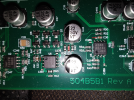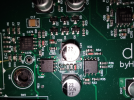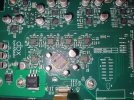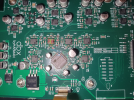deadwood83
Member
- Joined
- Sep 1, 2022
- Messages
- 93
- Likes
- 166
The story starts with me originally ordering a cloned Venu360 since some posters indicasted they seemed to be units which 'left' the DBX facility.
The seller did not have any VENUs (which was good after I saw Amirm's review) and the seller offered to sent two driverack PA2 clones instead.
They showed up and I was quite happy with them until...... Until I measured them. Damn you Cosmoas ADC!
The poor measurements, <60dBr multitone, <72dbR 1kHz FFT; left me shocked. I had to take a look inside. And inside I went.
There I found more Harmann markings, more obviously Harmann boards, genuine components, etc. ..... and also a ton of X7R or X5R resistors instead of NPO/C0G. The distortion was primarily due to odd-order harmonics which were MASSIVE.
This lead me eventually to this article. https://www.edn.com/signal-distortion-from-high-k-ceramic-capacitors/ (it has pictures!)
At this point I was about ready to get a miniDSP Flex, but my amps take balanced only, and my subs require discrete inputs (not line level) and they need some PEQ of their own. So to get an equivalent setup, I could get either two flexes, a flex and a miniHD for the subs, and then what would I do with my Loxjie D40? Hmmmmmmmm.
So onward I went, into the belly of the beast, carefully plucking each cap, measuring it, notating on my prepared photos, moving it aside, plucking the next, etc. This is a cheap Honeytek capacitance meter so the low pF readings are maybe +-10%, but the values showed up in various places on the Cirrus Logic datasheet for the audio codec.
I have ordered all new C0G and NP0 from LCSC consisting of Yageo and Murata units. Digikey/Mouser has nothing even close to a full BOM required. I ordered at least 2x as many as required for each part number.
Please enjoy the photos attached as I attempt to reverse-engineer this circuit to see if my hunch bears any fruit. The third and fourth images have some veeeery small text which will require some zoom to read. They mark out some traced circuits as well as some labels and pinouts It would appear there are three JRC4580 opamps between any in/output and the ADSP/Codec.
I'm sure the MiniDSP is a better product, of that I have no doubt. But I just need this to have a higher SINAD than my PA3s amplifiers. This was about $220 USD and if the caps bring it in-line with a genuine unit (93 SINAD) then I will be pleased as punch. Stay tuned for results.
Whoops! Totally forgot some sources. Look at all the C0Gs in this crappy screen from a crappy "repair" video. (YouTube)

I have nothing close to that many pearly whites in my units.
On the flex front, $600 USD is too rich for my blood (considering they use the same core componentry namely ADAU-21489, plus the $75 markup for different outputs, plus the constant $200 Dirac upsell) combined with needing a whole other interface chain just to add my subs, and no option for a balanced flexEight. If I can get the HackRack to hit 90 SINAD will I really ever hear the extra 10-20dB noise floor? Not with a projector and 1L mini pc in the same room and a refrigerator 40 feet away. I have no idea why they didn't offer 6 analog outputs unless they only use a 4-channel codec / dual 4 channel dac/adc which is then just split to make the 8. Oh; actually that's probably exactly it. But it is still slightly perplexing to me since they seem to cater to an audience which would run more than just 2-way speakers. Four channels is not enough for a 2-way + sub, four is too many for a simple passive xover 2.1. Four is overkill for a studio monitor setup. Maybe they were targeting people with passive stereo but two subs? Not sure, but four just seems like an odd choice for output channels. (Can you tell I want to buy the flex but just cannot rationalize it? I like it and I want to buy it, but it just doesn't make sense for my setup).
The seller did not have any VENUs (which was good after I saw Amirm's review) and the seller offered to sent two driverack PA2 clones instead.
They showed up and I was quite happy with them until...... Until I measured them. Damn you Cosmoas ADC!
The poor measurements, <60dBr multitone, <72dbR 1kHz FFT; left me shocked. I had to take a look inside. And inside I went.
There I found more Harmann markings, more obviously Harmann boards, genuine components, etc. ..... and also a ton of X7R or X5R resistors instead of NPO/C0G. The distortion was primarily due to odd-order harmonics which were MASSIVE.
This lead me eventually to this article. https://www.edn.com/signal-distortion-from-high-k-ceramic-capacitors/ (it has pictures!)
At this point I was about ready to get a miniDSP Flex, but my amps take balanced only, and my subs require discrete inputs (not line level) and they need some PEQ of their own. So to get an equivalent setup, I could get either two flexes, a flex and a miniHD for the subs, and then what would I do with my Loxjie D40? Hmmmmmmmm.
So onward I went, into the belly of the beast, carefully plucking each cap, measuring it, notating on my prepared photos, moving it aside, plucking the next, etc. This is a cheap Honeytek capacitance meter so the low pF readings are maybe +-10%, but the values showed up in various places on the Cirrus Logic datasheet for the audio codec.
I have ordered all new C0G and NP0 from LCSC consisting of Yageo and Murata units. Digikey/Mouser has nothing even close to a full BOM required. I ordered at least 2x as many as required for each part number.
Please enjoy the photos attached as I attempt to reverse-engineer this circuit to see if my hunch bears any fruit. The third and fourth images have some veeeery small text which will require some zoom to read. They mark out some traced circuits as well as some labels and pinouts It would appear there are three JRC4580 opamps between any in/output and the ADSP/Codec.
I'm sure the MiniDSP is a better product, of that I have no doubt. But I just need this to have a higher SINAD than my PA3s amplifiers. This was about $220 USD and if the caps bring it in-line with a genuine unit (93 SINAD) then I will be pleased as punch. Stay tuned for results.
Whoops! Totally forgot some sources. Look at all the C0Gs in this crappy screen from a crappy "repair" video. (YouTube)
I have nothing close to that many pearly whites in my units.
On the flex front, $600 USD is too rich for my blood (considering they use the same core componentry namely ADAU-21489, plus the $75 markup for different outputs, plus the constant $200 Dirac upsell) combined with needing a whole other interface chain just to add my subs, and no option for a balanced flexEight. If I can get the HackRack to hit 90 SINAD will I really ever hear the extra 10-20dB noise floor? Not with a projector and 1L mini pc in the same room and a refrigerator 40 feet away. I have no idea why they didn't offer 6 analog outputs unless they only use a 4-channel codec / dual 4 channel dac/adc which is then just split to make the 8. Oh; actually that's probably exactly it. But it is still slightly perplexing to me since they seem to cater to an audience which would run more than just 2-way speakers. Four channels is not enough for a 2-way + sub, four is too many for a simple passive xover 2.1. Four is overkill for a studio monitor setup. Maybe they were targeting people with passive stereo but two subs? Not sure, but four just seems like an odd choice for output channels. (Can you tell I want to buy the flex but just cannot rationalize it? I like it and I want to buy it, but it just doesn't make sense for my setup).
Attachments
Last edited:






 Sadly I can no longer edit my first two posts so my shame shall be eternal, but it is hardly the greatest eternal shame I have so it's alright. Thank you for pointing that out for future readers.
Sadly I can no longer edit my first two posts so my shame shall be eternal, but it is hardly the greatest eternal shame I have so it's alright. Thank you for pointing that out for future readers.